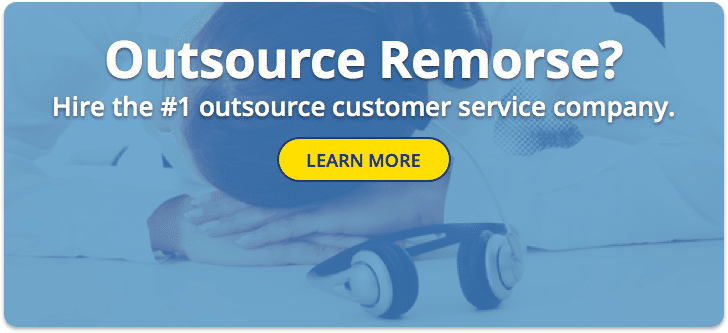16 Keys to Successful Contact Center Outsourcing
 “A great outsourcer should deliver positive outcomes for your KPIs. But, our experience shows there’s much more to demonstrating proof of outcomes than simply meeting KPIs.”
“A great outsourcer should deliver positive outcomes for your KPIs. But, our experience shows there’s much more to demonstrating proof of outcomes than simply meeting KPIs.”
Trends toward outsourcing contact centers will gain momentum in 2017. In fact, one of our projects for this year is to combine 4 dispersed centers into one command center for our client. If you are considering reshoring, outsourcing or consolidating centers, now is the time to begin thinking about how we use outcomes and evidence to improve center performance.
Healthcare quality relies heavily on outcome measurement. It examines how a patient does before, during and after treatment. Evidence-based medicine integrates clinical experience, patient values and available research to produce the best possible outcome for the patient.
Outcomes are critical in business as well, particularly in contact centers. Every customer interaction has the potential to add or detract from your company’s hoped-for outcomes. Sure, a great outsourcer should deliver positive outcomes for your KPIs. But, our experience shows there’s much more to demonstrating proof of outcomes than simply meeting KPIs.
We have a process of continuous improvement in our centers. We study the causes and effects of the center’s performance from a tactical, strategic and marketing standpoint. We base our improvement plans on demonstrable proof AND a thorough understanding of your customer journey. We look at each part of the delivery process effecting the user experience – even those outside of our call center control. That’s evidence-based quality improvement.
As organizations rethink their contact center strategies for 2017, we want to share 16 keys to successful contact center outsourcing – with an emphasis on evidence.
Successful contact center outsourcing requires an exchange of trust and transparency. Your center partner first needs to understand your business strategy. Then they have to know how to align their actions to obtain the business objectives. Your partner’s past performance should show proof of their expertise and willingness to invest in your success.
-
Are you looking to blend different lines of business (LOB) in this center?
Supporting evidence should include a cost/benefit analysis and a close examination of the agents’ skill overlap required for the tasks associated with each LOB. (This goes for all channels, virtual or otherwise.)
-
Explain your Quality Improvement (QI) approach and practices.
A 2015 Forrester report, Mind The Gap When Organizing To Support Contact Center Applications, points out how supporting contact centers with off-the-shelf CRM systems can be difficult, due to the complex, multilayered nature of the center. CRM systems and technical certifications are meant to impress, and they have merit. However, they can act as a smoke screen to cover a less-than-effective process or an overly expensive approach.
Avoid this with a cost/benefit comparison of the many CRM features versus a common sense approach using other methods to manage your program. Beware of being sold bolt-on CRM solutions or “systems” that add cost and complexity. At GCS, our QI approaches are rooted in process, metrics and dashboard management protocols.
-
What kind of languages would you use for this center? Will you hire interpreters?
First analysis the number of foreign-language calls. Including call volume and number of languages. Do you field enough calls in different languages to warrant hiring bilingual agents? If not, the use of an on-demand interpreter line is likely to be the best answer.
-
Vendor supply chain and related cost management strategies.
An outline of your potential outsourcer’s vendor management routine and associated costs is very helpful. A close study should reveal ways to adjust services and agents to meet budget. Vendors may also be a resource for new ways to handle old problems or reduce costs.
-
Current workflows and expectations for the future.
Ask your outsourcing candidate for a time and process study of existing workflows. Compare it to the suggested modifications. To validate the outcome, consider beta testing or using team input. It’s a good way to engage your employees with the process and be part of the solution.{{cta(’98f38b19-1371-4c85-aeb1-0d6d520286d6′)}}
-
What kind of access will a contact center partner need to service your program?
Having a plan for access during unplanned staff shortages is essential. Remote technology enables you to provide service during times of weather or influenza outbreaks, and enhances your ability to incorporate employees with disabilities. Remote access may help cut the costs of after-hours service or overflow. Your outsourcer should have the technology to optimize your center under all conditions.
-
Customer service workload distribution.
At GCS we manage daily call volumes and control costs by using:
- Skills-based routing
- Proven workforce management techniques
- Part-time workforce
Our workforce solutions typically enable us to handle higher volumes with fewer agents. Ask your candidate to describe their WFM protocols in detail. Have them use your history reports to model their staffing recommendations.
-
Staffing and reporting protocols.
An evidence-based staffing approach requires a close study of your situation and best-fit solutions. At GCS we would produce a recommended ratio of agents to team leaders based on your desired skill set, required service levels, past history and forecast.
We also look at all current reports and their use and then rank them for relevance. Next we offer recommendations for changes, deletions and/or new reports.
-
How are calls monitored? How is live work supervised?
Does your outsourcer record 100% of the calls and interactions to protect you and the customer? Do they have an experienced QA team and sample plan for sufficient review of each agent? They should have a track record of commitment to continuous improvement through coaching and analysis of live calls. Their process should provide daily feedback to each employee. This saves agent and supervisor time while catching issues as they occur.
-
What kind of industry software will you use?
The first step is to identify your needs and what software you’re already using. Your outsourcer should be in tune with current technology and what is most appropriate for your operation. They can realistically and cost-effectively propose what should be added or replaced.
-
How do you balance queue capacity and staffing?
What is the process management of the queue (IVR, routing, call flow, call backs, etc.)? And what are the workforce management techniques they use? How do they proactively encourage self-service to reduce overall cost without harming the customer experience? Ask for examples of how they have recently improved their process for other clients.
-
Handling call backs.
A good contact center should examine the benefits of call backs for keeping hold times low, but a great one will first focus on eliminating the cause of the hold – whether it’s a staffing issue, routing problem, or some other cause.
 “A good contact center should examine the benefits of call backs for keeping hold times low, but a great one will first focus on eliminating the cause of the hold – whether it’s a staffing issue, routing problem, or some other cause.”
“A good contact center should examine the benefits of call backs for keeping hold times low, but a great one will first focus on eliminating the cause of the hold – whether it’s a staffing issue, routing problem, or some other cause.”
-
What’s the plan for expanding IVR?
Researchers at Forrester recently identified the most common ways online consumers in the US seek help and service. “84% of US online consumers used web and mobile help or FAQs, 83% used the phone, 76% used email, 65% used chat, 56% used communities, and 43% used Twitter, for service.” Your candidate should offer a plan to offer IVR across your locations in tune with best practices and with a consistent customer interface that could be adopted throughout the service area.
-
Do you meet industry standards for measurement, reporting and trending?
Compliance is also important to support your organization’s business goals. An outline of the metrics and reports needed to manage your center now while providing data for proactive management in the future is a necessity. This includes an understanding of all laws, rules and regulations in place to protect the customer and the industry.
-
Best practices for QA and process improvement.
Best practices should be a significant part of your outsourcer’s process flow. QA and improvement options should be dependent on the final configuration of the center.
At GCS, we begin with the end in mind. This involves a top-down approach to understand culture, workflows, and human resources first. Then we build the required systems to support the outcomes of the organization.
-
Hiring and retention strategies.
The ideal candidate for your business should analyze your current workforce and selection criteria and compare that to industry benchmarks. They should retool the selection criteria based on the need of the position. Finally, review their hiring tactics and employee metrics to measure their success at selection. Look at results for both the first 90 days of employment and compare that to retention after 90 days.
If at anytime during your read of this blog you’ve wondered, “is this how GCS does it?” – yes it is. Our approach to contact center improvement has been a staple for over 15 years. Our process involves all phases of our people, process and technology. We hire the right people for the task and implement processes and technologies that work. This ensures we avoid costly mistakes for our clients. We enable our centers to optimize performance on each project we undertake.
These 16 keys are a small sample of what you can expect from a contact center organization driven by customer service – Global Contact Services. We really do live and breathe for YOUR customers. We would be glad to spend a few moments and talk about how that might work for you. Engage a top-shelf outsourcing company today!
Request more info today
Tell us about your program and we'll get back to you ASAP.

